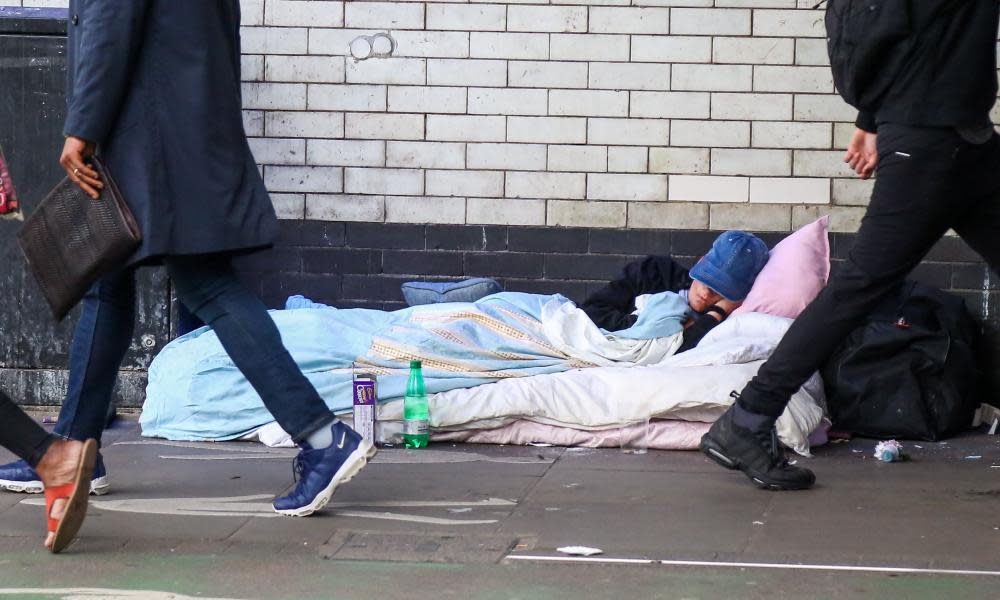24,000 sleeping rough or on public transport in UK, charity says

More than 24,000 people in Britain will spend the festive period sleeping rough or in cars, trains, buses or tents, according to new estimates that throw light on the scale of so-called “hidden” homelessness.
Research by the charity Crisis suggests 12,300 people are sleeping rough on the streets – the official figure is 4,751 – while a further 12,000 will spend the night in tents, cars, sheds, bins or night buses.
The figures suggest formal estimates of rough sleeping fail to capture the true scale of the problem. The Crisis figures, calculated by specialist researchers at Heriot-Watt University, suggest the number of rough sleepers in Britain has risen by 98% since 2010, and the number in tents and buses has increased by 103%.
The rough sleeping increases are more pronounced in England, at 120%, while in Scotland numbers have declined by 5% since 2010. In Wales, rough sleeping is estimated to have increased by 75% over the period.
The chief executive of Crisis, Jon Sparkes, said: “Christmas should be a time of joy, but for thousands of people sleeping rough, in tents or on public transport it will be anything but. While most of the country will be celebrating and enjoying a family meal, those who are homeless will face a struggle just to stay safe and escape the cold.
“This situation simply cannot continue. While the Scottish government has taken the first step in announcing a plan to eradicate homelessness, full implementation cannot come soon enough. Meanwhile, the governments in England and Wales must step up urgently with their own plans to end this crisis.”
The difference is likely to reflect Scotland’s more inclusive homelessness laws, introduced in 2012, which guarantee a right to settled accommodation to all homeless people, including young single men, unlike England where only those in “priority” need – such as families with dependent children – are housed.
On Thursday official figures showed that the number of homeless households in England living in insecure accommodation provided by their local council had risen again, with more than 120,000 children in temporary homes including bed and breakfast rooms and hostels.
The figures show 82,310 households were in temporary accommodation at the end of June 2018, up 5% on the previous year, and an increase of 71% since December 2010. More than 2,500 families were put up in bed and breakfasts, and 3,740 in hostels and refuges.
Greg Beales, a campaign director at Shelter, said: “The fact that more than 123,000 children in England will be forced to wake up homeless this Christmas is a tragedy. A cramped room in an emergency B&B or hostel is no place for a child to live.”
Record numbers of homeless families were placed in temporary accommodation outside of the borough where they are from – 23,640, up nearly 1,500 year on year, and a rise of more than 300% since the same period in 2010. The single biggest cause of homelessness was the ending of a tenancy in a private rented home.
The Chartered Institute of Housing’s chief executive, Terrie Alafat, said: “These figures reveal the stark reality of the homelessness crisis we are facing in this country – the fact that more than 120,000 children were living in temporary accommodation in June 2018 is quite simply a national disgrace.”
London councils were responsible for the lion’s share of households in temporary accommodation, at 56,000, followed by the south-east (8,610) and the east of England (5,940). There were just 160 in the north-east.
The increase in numbers in temporary accommodation in recent years are driven by rising rents and cuts to housing benefits, according to the National Audit Office. Last year it put the cost to councils in England – at a time when total numbers were 77,000 – at £845m a year.
The Local Government Association said: “Many councils are struggling to cope with rising homelessness and to find suitable accommodation for those in need. The increasing use of temporary accommodation is not only financially unsustainable for councils but is hugely disruptive for those families placed in such accommodation.”
The latest statistics are the first to begin to capture the impact of the government’s Homelessness Reduction Act, which came into force in April. This requires local authorities to do more to prevent households from becoming homeless, and is one of a series of measures introduced by the government to tackle homelessness, and rough sleeping in particular.
They show that 64,960 homelessness assessments were made under the new duties, and there are some suggestions in the data that councils’ preventive work may be beginning to have an effect in keeping at-risk people in their homes – although charities warned it was too early to tell.
The housing and homelessness minister, Heather Wheeler, said: “It is good to see our homeless reduction act making a real difference but we know we need to do more. That is why we are investing £1.2bn to tackle all forms of homelessness, we are putting £9bn into our affordable housing programme and we are also empowering councils to borrow to build more council homes to ensure that more people have a home of their own.”

 Yahoo News
Yahoo News 
